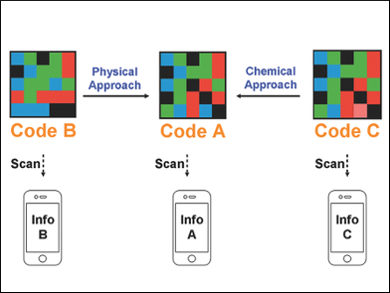The use of barcodes and similar codes has become indispensable. In general, there are three types of such codes: 1D barcodes using lines and spaces, 2D matrices, and 3D codes, whose third dimension is color. However, transforming information once it is encoded is typically difficult to achieve.
Jonathan Sessler, University of Texas at Austin, USA, and colleagues have developed fluorescent 3D hydrogel codes that allow the encoding of information that can subsequently be masked or transformed. The codes are fabricated from individual hydrogel squares based on cross-linked polyacrylamide and blue, green, and red fluorescent chromophores. Additionally, a complex of tethered tetracationic macrocyclic anion receptors was incorporated into the gels. This permits the physical adhesion between the single squares when placed on a nitrile substrate to form a multi-block adhesion array.
The team has demonstrated that the codes could be physically transformed or masked by cutting and reinserting a different hydrogel block. The codes could further be modified by chemical means by quenching the chromophores contained in a block to produce a new pattern. The researchers also attached a code to the back of a latex-gloved hand. The code could be read and masked during wearing, showing the promise of fluorescent hydrogel codes for wearable materials.
- Encoding, Reading, and Transforming Information Using Multifluorescent Supramolecular Polymeric Hydrogels,
Xiaofan Ji, Ren-Tsung Wu, Lingliang Long, Xian-Sheng Ke, Chenxing Guo, Yoo-Jin Ghang, Vincent M. Lynch, Feihe Huang, Jonathan L. Sessler,
Adv. Mater. 2018.
https://doi.org/10.1002/adma.201705480



